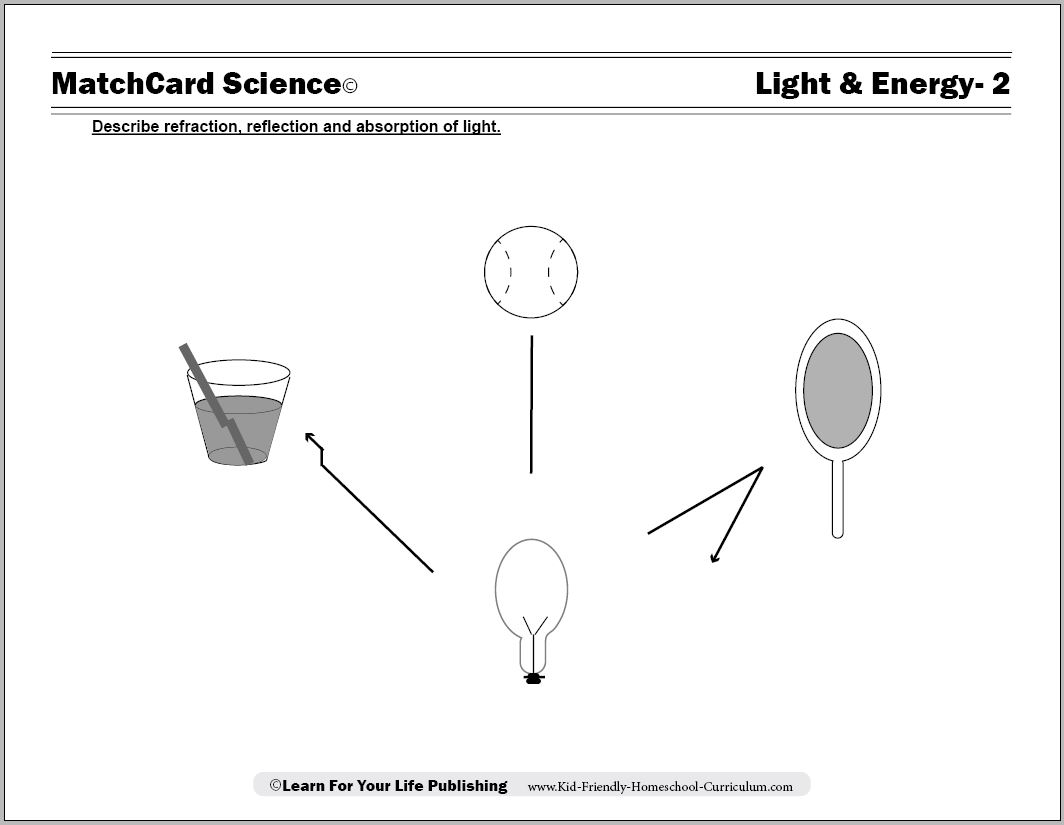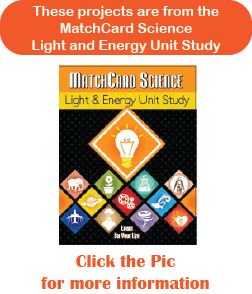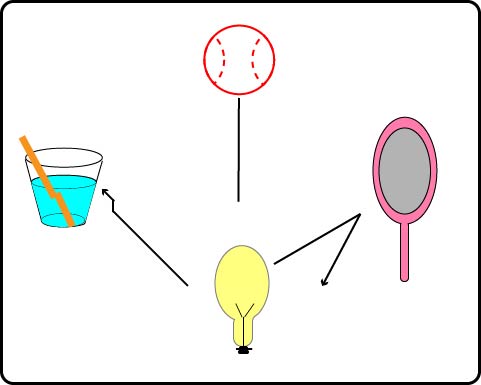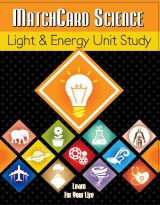Refraction and Reflection
The Refraction and Reflection Matchcard are from the Light and Energy Unit Study. This project will explain and demonstrate the refraction, reflection, and absorption of light waves.
Free Download Below


Refraction and Reflection Matchcard
Objective: Describe refraction, reflection and absorption of light.When light hits an object it is either absorbed (viewed as a colored object), refracted (bent), or reflected (bounced off the surface.)
MatchCard: Download below.
Project: Observe light that is reflected, refracted, or absorbed by objects.
Primt the Refraction and Reflection and Absorption MatchCard


This is MatchCard #2 of the Light and Energy Unit Study. Find more information on MatchCard Science below.
Bouncing, Bending, Colorful Light
Refraction of Light
Refraction is the bending of light. Here is a common illustration that demonstrates the phenomenon:Use a transparent glass.
Fill it 3/4 with water.
Put a straw, pencil, knife, or fork into the water.
When viewed from the side, it looks like the object is bent.
Explanation: Light waves pass through different media at different speeds. The light waves go slower through water than through air, giving the illusion that the object is bent.

Reflection of Light
Reflection is the bouncing of light waves off of the surface of an object.Use a flashlight and a mirror. Shine the light at the mirror and notice the beam of light reflecting off.
Change the angle of the light so it hits the surface at a 45% angle. Note the angle that the light is reflected off.
Draw a diagram showing the angles of light.
Convex and Concave
Using a metal spoon, discuss convex (curve outward) and concave (curve inward) surfaces.
Have the student note their reflection in the spoon. Which surface makes the image look larger? Smaller?
Draw a simple object like a pencil as it would appear in a convex and a concave shape.
Here is a more exagerated change: Look in the bottom of a can with a concave bottom (like shaving cream.) It will not work with a flat bottom can like a soup can. The reflection is upside down.
The Hunt
Sit in your room and note all the surfaces from which light is reflecting (shiny surfaces.)
Keep a record for a month of examples of reflection the student notes in their daily life. Examples: reflection strips at night, cats eyes, reflection in a pond.
Absorption of Light
When light hits a non-reflecting surface, the light waves are absorbed by the object. However, the light waves that are the same color as the object are not absorbed. Instead, those light waves bounce off the surface, are transmitted to the human eye, and are interpreted as the color of the object.Go into a closet, or pitch black room without any windows. It should be dark enough you see no objects. Slowly, let a little light in, either by opening the door a crack, or turning on a flashlight whose beam is almost completely covered. You should start to see the outline of objects, but not able to recognize their color. Slowly, allow more light into the room so objects are more distinct. Little by little, increase the amount of light in the room. Note when the color of the objects are recognizable.
To increase the challenge of this activity, you might want to have a set of items like blocks or marbles that come in different colors. Otherwise, the child might easily recognize the color of items that are already familiar.
Mirrors, Reflections, and Vision
This first activity is a prelude to the next two which require a wall mirror.Face to Face
Stand face to face with another person. They look into your eyes and you look at the top of their head. Slowly move your eyes down about one inch so you are staring at their forehead. Move your eyes down a little more. Then move them down again so you are looking into their eyes. They should say “Lock” when they know that you are looking into their eyes. You can feel and see when your eyes meet someone elses.Seeing Through Your Shades
Look at a reflection of yourself in the mirror. Notice that you can “lock” eyes with your own reflection. You can even lock eyes with yourself in a mirror if you are wearing sunglasses dark enough to prevent you from seeing the eyes.Mirror, Mirror, On the Wall
Now stand with your buddy, both of you looking into a wall mirror. Notice that you can lock eyes through the mirror, even though you are not facing each other. Your vision “locks” where they reflections meet, and not actually on the mirrors surface.MatchCard Science
How To Use MatchCards

Download the FREE MatchCard Science Instructor's Guide and see how MatchCards can make building their science knowledge base fun.
Light and Energy Unit Study

Download the entire Light and Energy unit study.
12 Science Unit Studies

Chemistry is only one of twelve complete unit studies for kids in 3rd to 8th grade.
Comprehensive objectives, hands-on projects, suggested science fair experiments, and the fun game-like MatchCards keep them interested in learning science. See all twelve MatchCard Science Unit Studies.
About Our Site
Hands-On Learning













